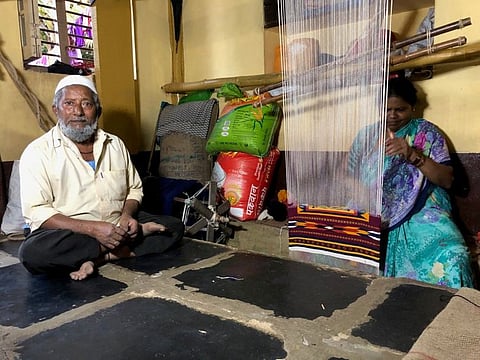Weaving lives together in Indian town: The last family standing
At Navalgund near Hubballi, a centuries old carpet weaving tradition is unravelling

Navalgund, Karnataka: As you ride past the sprawling green fields of Navalgund, a small town in northern Karnataka, serenades of India’s national bird welcome you from a distance.
A giant hill towers over the town, where the peacocks reign supreme, giving the town its name, which in the local Kannada language means ‘the hill of peacocks.’
However, Navalgund’s claim to fame is not its iridescent flock of peacocks, but the equally resplendent carpets that have come to be known as Navalgund Dhurries or Jamkhan.
Handwoven exclusively by the women folk of the Navalgund’s weaver community, the dhurries are woven on vertical looms and come mostly in rectangular shapes.
As is common with most carpet designs, these cotton rugs are usually available in floral motifs, with an exception of one non-floral pattern - the peacock.
Interestingly, rather than embellishing the floors, most people use these carpets to adorn their walls, which highlights their artistic value!
This unique handcrafted product has received a Geographical Indication tag from the government, which means no other carpet can use its name or borrow its style.
However, the fabric of this ancient craft with a rich history of over 400 years seems to be unravelling, despite a government initiative to provide the artisans with a central platform and training for new members of the community.
The town has a dedicated street known as Jamkhan (Dhurrie) Gully, where the craft community has lived for centuries. Though the street and the community still exist, but the craft has gradually faded away.
Until a few decades ago, Jamkhan Gully was home to dozens of carpet weavers, the locality now has only one old couple holding fort, safeguarding their unique ancestral weaving tradition against all odds.
Chequered, intricate and fascinating, Mumtaz and Shawkat Ali Shaikh have woven their lives together, just like rich tapestry of carpets they have created over the last four decades.
“I came to this house as a young bride. Hailing from a small village, I was a teenager with very little aspirations. I had no idea about any art or craft. Growing up, I had never seen a loom, let alone working on it,” said Mumtaz Shaikh, reflecting on the beginnings of her weaving journey.
Protecting secrecy of their craft
As unique as it is, being South India’s only cotton carpet weaving heritage, the Jamkhan community in Navalgund followed a unique tradition to ensure the protection and secrecy of their craft.
According to this tradition, neither the sons nor the daughters of the house were trained in the making of the carpet, only the daughters-in-law got the training to carry forward the heritage.
“Following this practice, I learnt the craft from my mother-in-law and eventually took over from her as the chief artisan of the family. It’s been almost 40 years now. All that I knew before marriage was that I was going into a family of artisans. Little did I realise that a few years down the line I would master this ancient craft,” adds the 55-year-old grandmother, walking down the memory lane.
When Mumtaz arrived at Jamkhan Gully around four decades back, the locality was still a thriving hub of carpet weavers, but now the area cuts a desolate picture.
“When I arrived here more than 30 families were practising this craft. Jamkhan was unique to this community. Then, a few years back, a government agency set up a workshop in the town and trained people from outside our community. Somebody from our own community gave away all the craft secrets and our community tradition was broken,” claims Mumtaz, highlighting one of the main reasons of the tradition’s decline.
As the state workshop flourished, the business in the Jamkhan Gully tapered off, with more and more artisans opting to work for the workshop, even as many wound up their age old practice.
“Once the new unit started running, our hold on the craft weakened and the business for the community dried up. One by one, the weavers dismantled the looms and abandoned the heritage, because with the workshop siphoning off bulk of the work, our weavers couldn’t survive on the left over. Some of them tried working for the agency, but most of them couldn’t continue,” said Shawkat Ali Shaikh, Mumtaz’s 69-year-old husband, who takes care of the business side of the work and assists her in peripheral tasks.
Now, the Shaikhs are the only family still running a magga (loom) at home.
However, with the age catching up quickly with the old couple and nobody in the family to carry forward the tradition, the couple is not sure for how long they can go on with the same level of energy and passion.
It is obvious that without the ancestral passion to keep the flame of tradition burning, this richly woven heritage will soon unravel and disintegrate forever.
Shafaat Shahbandari is a Bengaluru-based independent journalist. He is the founder of Thousand Shades of India, an alternative media platform that celebrates the diversity of India
Sign up for the Daily Briefing
Get the latest news and updates straight to your inbox







